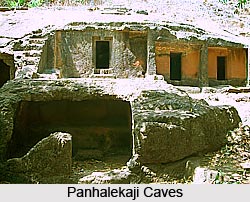
Panhalakaji Caves are situated in the Ratnagiri district of Maharashtra. Panhalakaji Caves comprises of 30 caves and thus makes a complex mirroring of the art and culture of that time. The Hinayana sect in Panhalakaji Caves began carving caves in 3rd century AD, beginning with the stupa in the current cave no 5.
Inscriptions in Panhalakaji Caves
Panhalakaji Caves have inscriptions of both Brahmi Script and Devanagari script. Brahmi Script is the modern name given to one of the oldest writing systems used in the Indian subcontinent and in Central Asia during the final centuries BC and the early centuries like its contemporary, Kharosthi which was used in India at that time, what is now Afghanistan and Western Pakistan. While on the contrary, Devanagari script is an abugida alphabet of India and Nepal. It is written from left to right, does not have distinct letter cases, and is recognisable by a horizontal line that runs along the top of full letters.
History of Panhalakaji Caves
In the 10-11th century AD another Buddhist group, a Vajrayana sect, established cave 10 in the cave complex of Panhalakaji Caves with their deities Akshobhya and Mahachandaroshana. They strengthened their practice in the region of Western Ghats. Lord Shiva or Mahadeva and Lord Ganesha were worshipped at the site during Silahara rule. Shilahara Dynasty was a feudal clan of ancient era that established itself in northern and southern Konkan Region and southern Maharashtran part during the glorious rule of Rashtrakuta.
Architecture and Attractions of Panhalakaji Caves
Panhalakaji Caves consists of 30 caves that were engraved in the period of Rashtrakuta and other times of ancient history of India. But the most spectacular are the Cave 10 of Panhalakaji Caves. It proposed the image of Maha-Chandraroshana. This deity is shown on the Stupa which signifies the connection of Ratnagiri of Odisha with ancient Buddhist sites of Odisha. Buddhism was known in Odisha right from the time of its inception, though the Lord Buddha never visited Odisha during his lifetime. The Buddhist chronicles refer to Kesa Asthi was brought to Odra by two rich traders of that time, Tapassu and Bhallika. In the subsequent period, the nail and tooth relics of Gautama Buddha too entered into Odra. The Cave 14 depicts the deity of Nath Pantha or Natha Order of Buddhism. The Cave 19 of Panhalakaji Caves has Shivlinga in it, which determines the collage of both Hinduism and Buddhism in the later phase of early history of India. It has Hindu scriptures on its ceiling. The cave 29 of Panhalakaji Caves was used by Nath Pantha or the followers who believed in Natha Doctrine and was renamed as Gaur Lena.
Discovery of Panhalakaji Caves
The beginning of digging of this cemetery was from the 2nd or 3rd century. During that period the technical Vajrayana sect of the docks were dug from around 8th to 11th centuries. Proof of this has been unearthed later. On the left side of the Nante village, the wings of the wings spread on the left. There are 29 caves dug in the mountains on the banks of the Coonjai river. Of these, 28 caves are north-facing and the 29th lake is located in the small hill station which is known as Gourleane. Here, along with Buddhist and Nath sect sculptures, Ganpati, Lakshmi, Saraswati, Shivling etc. deities are also found.
Visiting Information of Panhalakaji Caves
Nearest rail station to Panhalakaji Caves are Khed and Ratnagiri. The NH4 highway near Depoli is nearest stop to Panhalakaji Caves.





















